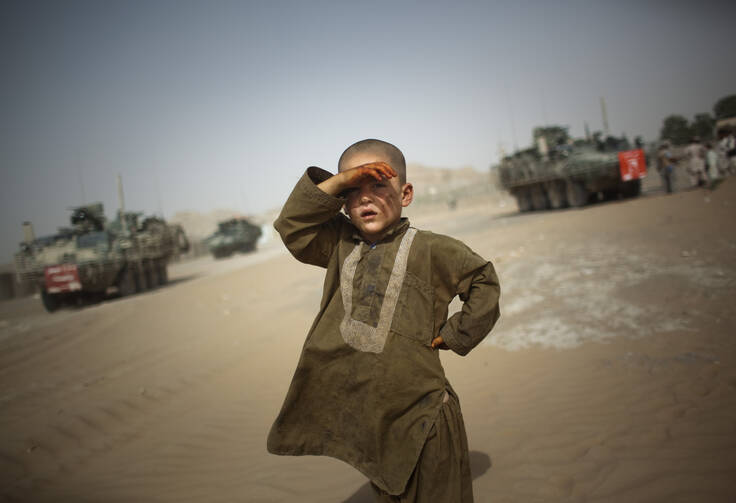Just a few weeks after the attacks of Sept. 11, 2001, and at the commencement of U.S. military operations in Afghanistan, the U.S. Conference of Catholic Bishops issued their eloquent pastoral message “Living With Faith and Hope After September 11.” Alongside words of sorrow, consolation and prayer, the bishops offered “moral guidance on how the world should respond justly to terrorism in order to re-establish peace and order.”
Drawing on just war theory, the bishops argued that military force can be a “legitimate” part of that response, as long as it was pursued with regret and restrained by classic just war principles, especially that it be proportionate and respect civilian immunity from attack. On that last point, the bishops emphasized that “[i]n our response to attacks on innocent civilians, we must be sure that we do not violate the norms of civilian immunity and proportionality.”
They warned, however, that while “military action may be necessary” as a response to 9/11, “it is by no means sufficient.” Much of the statement focused on the need for a wide range of nonmilitary measures. In addition to better intelligence and security, these included addressing the “roots of terrorism” through a “long term focus on broader issues of justice and peace.” The peacemaking agenda outlined by the bishops called for global cooperation to target scourges like poverty, tyranny, corruption, the arms trade and human rights abuses, which provide the “fertile ground in which terrorism can thrive.”
The U.S. bishops in 2001: "In our response to attacks on innocent civilians, we must be sure that we do not violate the norms of civilian immunity and proportionality."
The statement was a good representation of contemporary Catholicism’s approach to questions of war and peace. While traditional just war theory considered warfare a normal part of international relations, in the 20th century the church became more critical of it, especially after the Second Vatican Council urged “an evaluation of war with an entirely new attitude.” Resorting to war remained morally permissible in some narrow circumstances, but Catholic teaching also began articulating a powerful critique of war itself, focusing in particular on its indiscriminate destructiveness, immense human suffering and tendency to feed cycles of violence.
Positive Peacemaking
In this framework, peace is not merely war’s absence but rather, in St. John Paul II’s words, “the fruit of justice,” one that needs building up through positive peacemaking—alleviating global poverty and inequality through sustainable economic development; promoting democracy, the rule of law and human rights; strengthening international law, arms control agreements and institutions like the United Nations; and relying on nonviolent alternatives to war like diplomacy, mediation and grassroots civil resistance. The ultimate aim of this development in Catholic teaching became the abolition of war itself, reflected in the mantra “Never again war,” invoked by popes from St. Paul VI in 1965 onward, and in St. John Paul II’s demand in 1991 that the world “proceed resolutely toward outlawing war completely.”
Should church teaching still allow for morally permissible uses of military force in certain situations? Or should it phase out this remaining space for just wars entirely?
This developing critique of war and the peacemaking agendas since Vatican II have prompted questions about the continuing place of just war theory in Catholic teaching. Should church teaching still allow for morally permissible uses of military force in certain situations? Or should it phase out this remaining space for just wars entirely? Most cases for keeping some place for just war theory emphasize the realities of the world today, arguing that sometimes war is necessary to protect against aggression or prevent mass atrocities. Most cases for phasing it out, on the other hand, emphasize theological and moral themes, arguing that warfare is incompatible with Jesus’ Gospel message and the church’s commitment to the sanctity of life.
War: What Is It good for?
I am certainly sympathetic to the theological and moral critique of just war theory, but I also think the realist case for it in today’s world is actually much weaker than many people realize. The evidence on armed conflict, especially what we have learned in the two decades since the 9/11 attacks, indicates that warfare is an especially ineffective tool for achieving the very goals just war theory sets for it, especially compared with the nonmilitary methods Catholic teaching increasingly emphasizes (I detail this evidence in more detail here, here, and here).
Take terrorism. The bishops were following just war theory when they endorsed the legitimacy of military action in response to the kind of lethal aggression against innocent lives that we saw on September 11. But even if justified in theory, in reality warfare is a terrible way to combat terrorism. The post-9/11 outpouring of research on terrorism confirms its resistance to battlefield solutions. As a form of asymmetric warfare, terrorism provokes military responses that tend to backfire and bog down countries in lose-lose situations, as the American experience in Afghanistan and elsewhere illustrates. A military response is what terrorist groups want, since it validates their self-image as soldiers fighting for a cause and tends to increase their support among the population they claim to be fighting for.
Even if justified in theory, in reality warfare is a terrible way to combat terrorism.
Much more effective is a two-pronged strategy. First, intelligence and law-enforcement efforts can exploit the vulnerability of terrorist groups, who must commit a series of crimes in preparation for their attacks—from conspiracy to smuggling to money laundering to forgery. This method is equally effective for targeting domestic terrorism, which is a threat as great or even greater to countries like the United States than the international kind. Second, where possible, resolving underlying political disputes (as the British finally tried to do in Northern Ireland) so that terrorists become cut off from the sympathetic local population they need for money, recruits, safe houses and other resources is essential.
Of course, terrorism is only one type of threat. Just war theory also legitimizes war as a way to prevent or defeat even larger-scale injustices against one’s own country or vulnerable others: invasions, violent dictatorships or mass atrocities like ethnic cleansing or genocide. But here too, war’s actual record is poor, especially compared with alternatives. Armed resistance to invasions and dictatorships, whether domestic or through a foreign intervention, is more likely to fail than to succeed, usually only extending violent conflicts and making oppressive regimes more likely in the end. It also actually increases rather than decreases the risk of mass atrocities.
The effectiveness of nonviolence
Fortunately, there is a better option. In the last two decades, a remarkable line of empirical research, typified by Erica Chenoweth and Maria Stephan’s groundbreaking Why Civil Resistance Works, has been analyzing hundreds of violent and nonviolent resistance efforts around the world stretching back over a century. These researchers have found that nonviolent methods of noncooperation and disruption are two to three times more effective than military methods for defeating oppressive regimes or foreign occupiers, regardless of how brutal the opponent. While military efforts almost always produce a new violent dictatorship, most successful nonviolent movements result in a durable democracy (as well as higher economic growth). And, even though it is much more likely to fail, military opposition is three times more likely to lead to mass killing by the target regime compared with the more successful nonviolent methods.
The best argument against just war theory’s continuing place in Catholic teaching may not be that it is necessarily wrong in theory, but that it misunderstands the realities of war and peace today.
There is a popular myth that the international arena is a state of nature, in which countries only respect armed force; but those who study it closely find that most countries, while still often acting in self-interest, are in reality constrained by nonmilitary norms and institutions. A web of diplomatic relationships, incentives, sanctions, intergovernmental organizations and treaty regimes do shape state behavior. This does not happen perfectly or in a way every country would like, but it works more effectively than warfare. Indeed, even though there are plenty of international disputes simmering at any given time, actual warfare between separate countries has become remarkably rare in today’s world, where the majority of remaining armed conflicts are internal civil wars.
Perhaps most important, Catholic teaching is correct that nonmilitary methods can also address the roots of war itself. In contrast, rather than being an effective solution to aggression or mass atrocities or terrorism, warfare increases the prevalence of all of these. Ethnic cleansing and genocide almost always happen in the context of a war already underway. As Christina Lamb describes in detail in her harrowing recent book Our Bodies, Their Battlefields, mass rape is a regular feature of warfare (even St. Augustine called it a “customary evil” of war). And 95 percent of suicide attacks are in response to the military occupation of an identified homeland.
Prevention over intervention
So war itself is a security threat, but the good news is that we also know how to help prevent it. Key factors that reduce a country’s risk of experiencing war include sustainable economic development, especially reductions in severe poverty; responsive democratic governance and the rule of law; political and civil rights, especially for women and ethnic or religious minorities; and integration into regional or global intergovernmental bodies. Trying to impose these by military force usually fails, as the United States has once again learned after 9/11, but patient efforts by the international community using nonmilitary alternatives has proven effective, even if difficult.
It may be that Pope Francis has already answered the question of just war theory’s future in Catholic teaching.
Since most wars today are chronic civil wars, going through cycles of stops and restarts and concentrated in a few regions of the world, peacemaking efforts have the most potential in these cases. Researchers have detailed how diplomatic engagement using a combination of incentives and sanctions can successfully push parties toward cease-fires and mediation, producing negotiated settlements implemented with the help of neutral third-party monitors and allowing space to build up transitional justice mechanisms and long-term political and economic institutions. Such an approach, while not as dramatic as military interventions in civil wars, has a much better record of success in ending them and preventing violent restarts.
Misunderstanding realities
The best argument against just war theory’s continuing place in Catholic teaching may not be that it is necessarily wrong in theory, but that it misunderstands the realities of war and peace today. Given that the nonmilitary alternatives increasingly emphasized in Catholic teaching are more effective in practice, keeping just war theory’s sanction of warfare may do more harm than good—like keeping an ineffective medication with terrible side effects as a treatment option when health research has established safer and more effective alternatives. The idea that war can be “legitimate” because “necessary,” to use the words of the bishops in their 9/11 message, can distract from the more powerful and effective nonmilitary options they also emphasized, leading to the kind of war-as-solution thinking that led the United States into so many military misadventures after 9/11.
In this way, just war theory’s parallels to capital punishment in Catholic teaching are revealing. Having once accepted the death penalty as an unfortunate but necessary part of normal responses to crime, the church gradually became more critical of it, eventually deeming it justified in theory but not in actual practice, given real-world alternatives, calling for its abolition and finally declaring it completely “inadmissible.” It is telling that Pope Francis chose to include just war theory and capital punishment in the same section of last year’s encyclical “Fratelli Tutti” and to suggest that since the idea of a just war is no longer possible in the contemporary world, it is something “we no longer uphold in our own day” (No. 258, Footnote 242).
It may be that Pope Francis has already answered the question of just war theory’s future in Catholic teaching.








